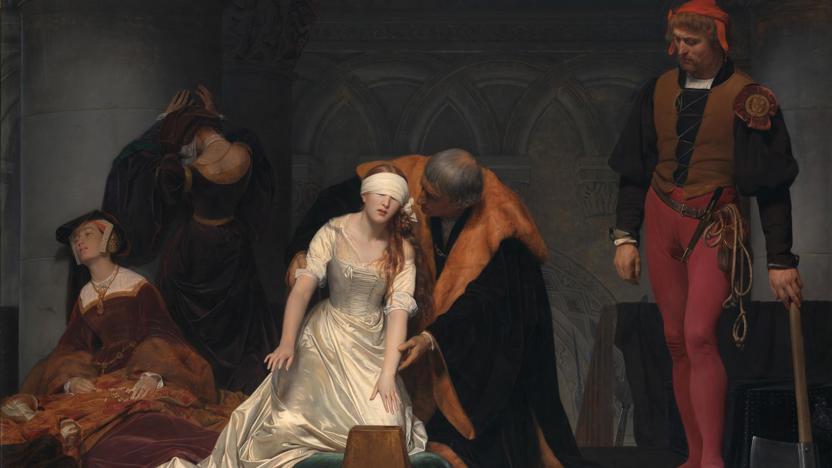Paul Delaroche's 'The Execution of Lady Jane Grey'
Audio description
This is a description of 'The Execution of Lady Jane Grey' by Paul Delaroche. Oil on canvas, it is approximately two and half metres high by 3 metres wide, in a gold frame. It was painted in 1833.
This huge painting tells the story of Lady Jane Grey, who was queen of England for nine days, before being imprisoned and then executed in 1554, at the age of nearly 17. This was on the orders of Mary, one of the daughters of Henry VIII, who became queen in her stead.
The setting is intended to be the Tower of London, with a backdrop of grey-stone Gothic arches, and thick columns. Five close to life sized figures are on a stage-like platform, which is covered in a black cloth. In the centre, facing us, is Lady Jane, glowing in a white satin underdress, with elbow length sleeves and a tightly-laced bodice. The folds of the long, full skirt spill over the left edge of the sumptuous green cushion she kneels on. Her skin is pale, her rosebud mouth pink, and her long blond hair falls over her left shoulder. She is blindfolded with a thick white cloth, and her outstretched hands grope for the wooden block in front of her. It stands on a small pile of straw, a ghoulish reminder of what is to come
Lady Jane’s hands are guided towards the block by the Lord Lieutenant of the tower, Sir John Bridges, who stoops over her from behind. In contrast to Lady Jane he is grey haired and bulky, in a black gown with a huge brown fur collar, But his body language conveys tenderness and compassion. His face is in shadow, yet the angle of his head suggests he could be whispering in her ear.
The executioner stands waiting on the right, head bowed, apparently lost in solemn thought. He holds his axe loosely at his side, the blade resting on the floor. He wears a black doublet with puffed sleeves, under a brown waistcoat, a dagger and rope tucked into his belt. However, his tight fitting hose, the name given to the tights worn by men at the time, are cherry red, as is his cap, both providing a splash of warmth. But they also anticipate the bloody deed to come, as does the glimpse of a black coffin behind him.
Two distraught Ladies-in-waiting are to the left. One is seated on the floor. On her lap of orange-brown billowing skirts are Lady Jane’s outer dress and jewellery, in rich reds and golds. Like the executioner on the right, she provides some colour. The Lady behind her wears black. She has her back to the scene, head bowed, hands pressed in despair against a stone column.
Delaroche’s meticulous technique gives a smooth mirror like finish which renders the scene almost photographically real. The composition is carefully staged, flanked by the strong verticals of the thick stone column to the left and the executioner to the right. The poses are varied across the painting – seated, standing, kneeling, and bending, everyone either focused on Lady Jane, or averting their gaze.
Between the executioner and Sir John is a glimpse of the top of a staircase that leads down behind the platform. There must be soldiers below as the spiked tops of their weapons, known as halberds, protrude, reminding us there is no way out for the deposed queen.
In fact Lady Jane Grey would have been executed outside at the Tower of London, and she is reported to have gone to her death very bravely.
The painting was exhibited at the Paris Salon in 1834 and was hugely successful with the public, as it remains today.


